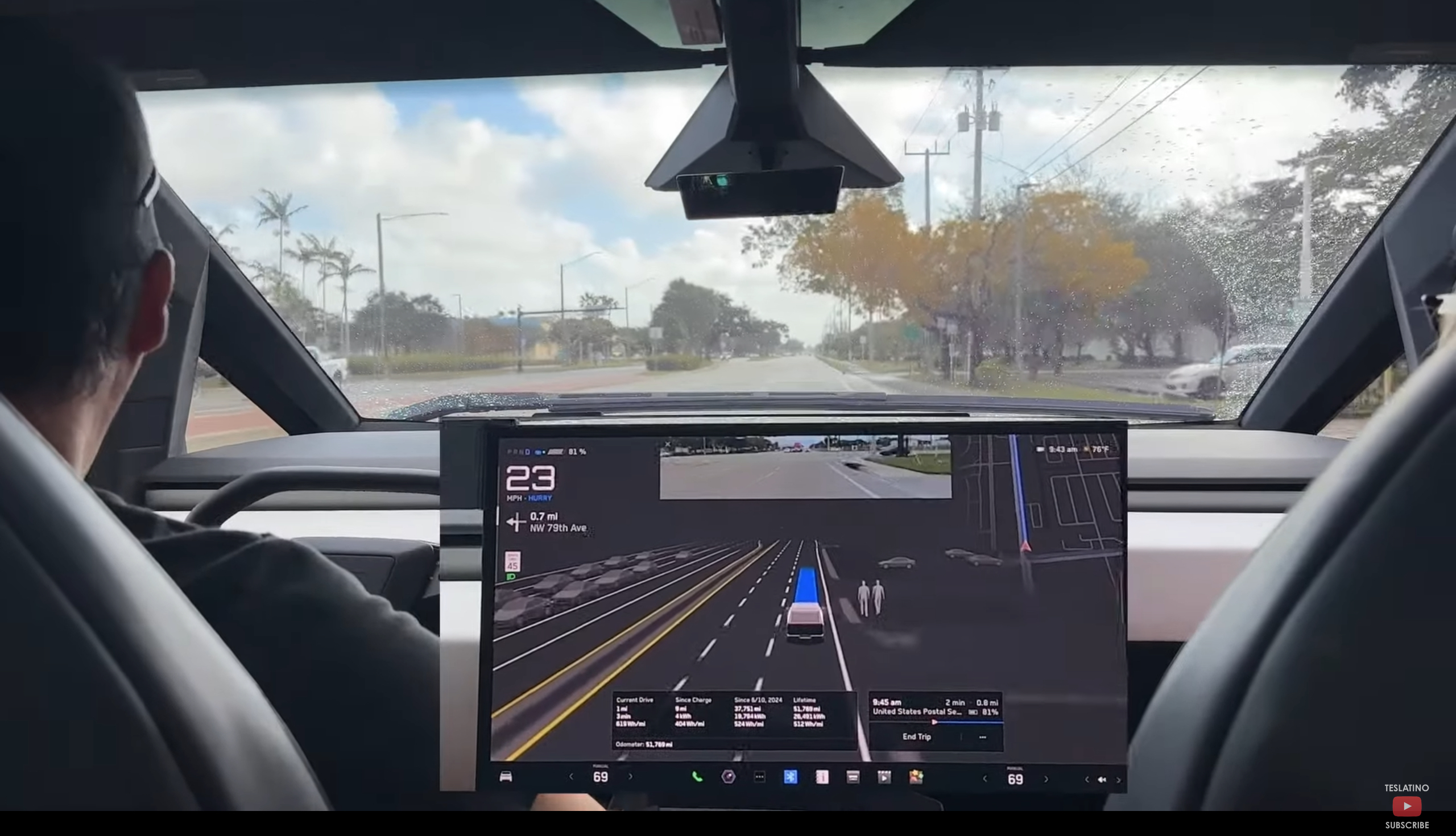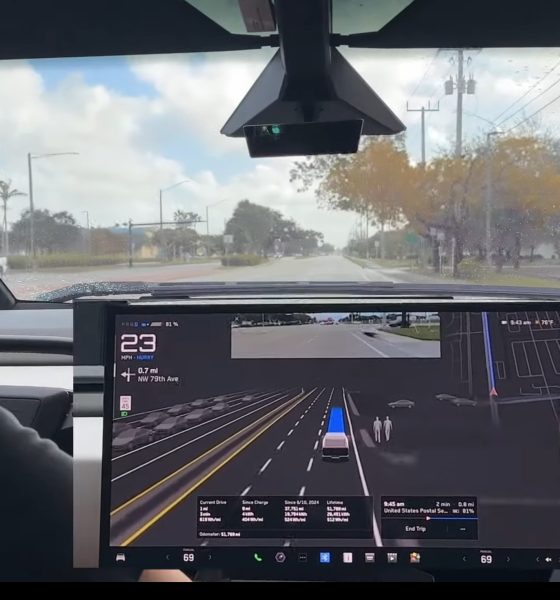

News
Tesla rolls out latest FSD version, shares upcoming HW3 deployment plans
Tesla has begun rolling out its latest version of Full Self-Driving (FSD) Supervised this week to those with its most recent computer hardware, along with providing an update on when those with older FSD computers can expect new updates.
While Tesla began rolling out its FSD Supervised v13 a couple of weeks ago, the company has begun a wider rollout of its latest version, FSD Supervised v13.2.1, to those with Hardware 4 (HW4), or AI4, computers, as confirmed by Autopilot program lead Ashok Elluswamy on X on Monday.
Those with Hardware 3 (HW3)—often called AI3 after Elon Musk dubbed upcoming the FSD computers with AI rather than HW during this year’s Shareholder Meeting—are also set to get a new version before the end of the year, according to Elluswamy.
“FSD v13.2.1 is now rolling out wide to AI4 customers! That plus the holiday vehicle software update is coming within a week,” he wrote. “Team’s working on a much updated v12.6 for AI3 customers by end of this year.”
READ MORE ON TESLA’S FSD SUPERVISED: Tesla is working on new parking features for Full Self-Driving
The news comes as many Tesla owners with older vehicles have criticized the company for rolling out new, well-performing FSD Supervised versions only to those with newer vehicles and internal computers, with Elluswamy’s response highlighting that the company is still debuting new versions for those with the older hardware.
Although Musk also said during the meeting that there was a slight chance that Unsupervised FSD may never be able to run on AI3 vehicles, he emphasized that, if that were the case, Tesla would upgrade AI3 vehicles whose owners purchased FSD. The Tesla CEO has also said that AI5 is expected to be used in Optimus and all newly produced cars by the end of 2025.
Initial reviews of Tesla’s FSD Supervised v13
Tesla’s FSD Supervised v13.2.1 follows the debut of v13 and v13.2, which have been garnering positive reviews since the initial version was first launched just weeks ago. In addition to going from park-to-park in the v13 suite, the software has been spotted navigating some tricky situations that past versions didn’t seem to be capable of handling.
Early reviews of FSD Supervised v13.2.1 have been similar, with some sharing video of their cars avoiding road obstacles, cautiously navigating around other vehicles making traffic violations, and more while using the software. You can see one particular review below, courtesy of X user Greggertruck, who was using the software while driving his Cybertruck.
Cybertruck just totally avoided some junk in the turn lane, waiting to switch until it passed. ? Obstacle avoidance seems improved in FSD V13.2.1 you’re wild @Tesla_AI pic.twitter.com/zajda8jRvK
— Greggertruck (@greggertruck) December 16, 2024
Tesla has been rolling out Cybertruck FSD updates at slightly different times than for most other AI4 vehicles, and the recent release of v13.2.1 also came with slightly different release notes than those seen in Model Y and other vehicles.
FSD 13.2.1 release notes Y vs Cybertruck
Same FSD release, different release notes pic.twitter.com/mmTmBIEP28— Dirty Tesla (@DirtyTesLa) December 15, 2024
For one, the release notes don’t include the integrated unpark, reverse, and park capabilities that make the version go from “park-to-park.” Additionally, it doesn’t feature the highly anticipated Actually Smart Summon, which is expected to come with a future update.
You can watch more footage of early FSD Supervised v13.2.1 experiences below from Teslatino, who uses the software to drive to the Post Office in his Cybertruck.
What are your thoughts? Let me know at zach@teslarati.com, find me on X at @zacharyvisconti, or send us tips at tips@teslarati.com.
Tesla highlights FSD safety in edge case test videos



Elon Musk
Elon Musk confirms xAI’s purchase of five 380 MW natural gas turbines
The deal, which was confirmed by Musk on X, highlights xAI’s effort to aggressively scale its operations.

xAI, Elon Musk’s artificial intelligence startup, has purchased five additional 380 MW natural gas turbines from South Korea’s Doosan Enerbility to power its growing supercomputer clusters.
The deal, which was confirmed by Musk on X, highlights xAI’s effort to aggressively scale its operations.
xAI’s turbine deal details
News of xAI’s new turbines was shared on social media platform X, with user @SemiAnalysis_ stating that the turbines were produced by South Korea’s Doosan Enerbility. As noted in an Asian Business Daily report, Doosan Enerbility announced last October that it signed a contract to supply two 380 MW gas turbines for a major U.S. tech company. Doosan later noted in December that it secured an order for three more 380 MW gas turbines.
As per the X user, the gas turbines would power an additional 600,000+ GB200 NVL72 equivalent size cluster. This should make xAI’s facilities among the largest in the world. In a reply, Elon Musk confirmed that xAI did purchase the turbines. “True,” Musk wrote in a post on X.
xAI’s ambitions
Recent reports have indicated that xAI closed an upsized $20 billion Series E funding round, exceeding the initial $15 billion target to fuel rapid infrastructure scaling and AI product development. The funding, as per the AI startup, “will accelerate our world-leading infrastructure buildout, enable the rapid development and deployment of transformative AI products.”
The company also teased the rollout of its upcoming frontier AI model. “Looking ahead, Grok 5 is currently in training, and we are focused on launching innovative new consumer and enterprise products that harness the power of Grok, Colossus, and 𝕏 to transform how we live, work, and play,” xAI wrote in a post on its website.
Elon Musk
Elon Musk’s xAI closes upsized $20B Series E funding round
xAI announced the investment round in a post on its official website.

xAI has closed an upsized $20 billion Series E funding round, exceeding the initial $15 billion target to fuel rapid infrastructure scaling and AI product development.
xAI announced the investment round in a post on its official website.
A $20 billion Series E round
As noted by the artificial intelligence startup in its post, the Series E funding round attracted a diverse group of investors, including Valor Equity Partners, Stepstone Group, Fidelity Management & Research Company, Qatar Investment Authority, MGX, and Baron Capital Group, among others.
Strategic partners NVIDIA and Cisco Investments also continued support for building the world’s largest GPU clusters.
As xAI stated, “This financing will accelerate our world-leading infrastructure buildout, enable the rapid development and deployment of transformative AI products reaching billions of users, and fuel groundbreaking research advancing xAI’s core mission: Understanding the Universe.”
xAI’s core mission
Th Series E funding builds on xAI’s previous rounds, powering Grok advancements and massive compute expansions like the Memphis supercluster. The upsized demand reflects growing recognition of xAI’s potential in frontier AI.
xAI also highlighted several of its breakthroughs in 2025, from the buildout of Colossus I and II, which ended with over 1 million H100 GPU equivalents, and the rollout of the Grok 4 Series, Grok Voice, and Grok Imagine, among others. The company also confirmed that work is already underway to train the flagship large language model’s next iteration, Grok 5.
“Looking ahead, Grok 5 is currently in training, and we are focused on launching innovative new consumer and enterprise products that harness the power of Grok, Colossus, and 𝕏 to transform how we live, work, and play,” xAI wrote.
Investor's Corner
Tesla gets price target bump, citing growing lead in self-driving

Tesla (NASDAQ: TSLA) stock received a price target update from Pierre Ferragu of Wall Street firm New Street Research, citing the company’s growing lead in self-driving and autonomy.
On Tuesday, Ferragu bumped his price target from $520 to $600, stating that the consensus from the Consumer Electronics Show in Las Vegas was that Tesla’s lead in autonomy has been sustained, is growing, and sits at a multiple-year lead over its competitors.
CES 2026 validates Tesla’s FSD strategy, but there’s a big lag for rivals: analyst
“The signal from Vegas is loud and clear,” the analyst writes. “The industry isn’t catching up to Tesla; it is actively validating Tesla’s strategy…just with a 12-year lag.”
The note shows that the company’s prowess in vehicle autonomy is being solidified by lagging competitors that claim to have the best method. The only problem is that Tesla’s Vision-based approach, which it adopted back in 2022 with the Model 3 and Model Y initially, has been proven to be more effective than competitors’ approach, which utilizes other technology, such as LiDAR and sensors.
Currently, Tesla shares are sitting at around $433, as the company’s stock price closed at $432.96 on Tuesday afternoon.
Ferragu’s consensus on Tesla shares echoes that of other Wall Street analysts who are bullish on the company’s stock and position within the AI, autonomy, and robotics sector.
Dan Ives of Wedbush wrote in a note in mid-December that he anticipates Tesla having a massive 2026, and could reach a $3 trillion valuation this year, especially with the “AI chapter” taking hold of the narrative at the company.
Ives also said that the big step in the right direction for Tesla will be initiating production of the Cybercab, as well as expanding on the Robotaxi program through the next 12 months:
“…as full-scale volume production begins with the autonomous and robotics roadmap…The company has started to test the all-important Cybercab in Austin over the past few weeks, which is an incremental step towards launching in 2026 with important volume production of Cybercabs starting in April/May, which remains the golden goose in unlocking TSLA’s AI valuation.”
Tesla analyst breaks down delivery report: ‘A step in the right direction’
Tesla has transitioned from an automaker to a full-fledged AI company, and its Robotaxi and Cybercab programs, fueled by the Full Self-Driving suite, are leading the charge moving forward. In 2026, there are major goals the company has outlined. The first is removing Safety Drivers from vehicles in Austin, Texas, one of the areas where it operates a ride-hailing service within the U.S.
Ultimately, Tesla will aim to launch a Level 5 autonomy suite to the public in the coming years.








